As promised I'm going to post my experiences of painting with an airbrush over the last 18 months. I hope I'm able to pass on a little bit of help to those who are thinking about giving airbrushing a go, and give a little confidence to anyone who (like I was) maybe a little daunted about having a stab at an alternative way of painting our minitures.
CHOOSING AN AIRBRUSH.
1st off let me stress, whilst some armies and models really lend themselves to being airbrushed not all do. You can get some really nice results but I find a mix of airbrushing and painting by hand is what gives me the best results I can achieve at the moment. Also before I go any further I would like to stress I'm no expert either. I'm a novice but just decided to give airbrushing a go.
Right then, 1st thing we need to start airbrushing is of course an Airbrush and an air source. 1st the airbrush.
I have tried 2 types of airbrush. Gravity feed and bottle feed. A gravity fed airbrush has a little pot on the top or side of the airbrush where you pour your paint directly into. Here's a picture
This one as you can see is also a double action airbrush. I will explain later what this means and why it's best for us in our hobby.
The second type of airbrush you generally see is a bottle feed airbrush. You place the paint your going to use in a glass jar that's then attached to the airbrush underneath. As you pull back the trigger the airbrush sucks paint fron the jar.
They generally look like this one.
Now I have tried both and I can honestly say for us a gravity fed airbrush is the best choice. The cup in the top is easy to fill and there is much less wastage of paint. Also I have found this type of brush doesn't clog up as easily. Also having an underslung bottle is a pain and can really get in the way when your painting. However some airbrush starter kits do come with one of each type of airbrush. I used to use the bottle fed one for priming and the gravity fed one for actual painting. Me now I use just a gravity one for everything.
Another thing to look for when choosing an airbrush is needle size, most are either 0.4mm (great for priming or large stuff) of 0.2mm (better for more detailed painting). Starting out I suggest sticking with a 0.4mm. Sure your not going to get anything fancy done but you will be able to do some blending and get a few overspray effects. I will explain more as I go along. The reason I say go for a 0.4mm 1st is to practice with the larger size.This won't clog as much and it will give you a "feel" for how the paints you use and your airbrush work. Some airbrushes actually allow to switch sizes of needle very easily. Whatever you choose though, please go out and buy some cheap paper or card to practice on before you start on any expensive models. Take your time and get a feel for your airbrush.
Earlier I mentioned 2 other options to our airbrushes. Single action and Double action (sometimes called dual action). Single action is basically you push down the button, pull back and paint comes out. Basically it's the same result you would get from a can of spray paint. Ok for priming but not enough control for what we want. The second and better option is a double action airbrush. What this means is more control. The further back you pull the trigger on these types of airbrush, the more paint will come out. This is great for extra control and allows us to paint with more confidence, knowing we're less likely to accidentally cover our models with loads of paint.
So to recap on what kind of airbrush I think is best for us. Gravity feed double action. That gives us an airbrush with nice control, no jars getting in the way and easy to clean.
That's it for now, don't rush out and buy anything yet though because in my next post I'm going to talk about my experiences with different air sources and what deals we can find thst give us the best flexibility.
One last thing, those of you who have the GW air gun thingy. That's not an airbrush, it's ok for priming and base coats. But that's about it really. It's got its uses but it's not an airbrush.
If anybody has anything to ask or add (I'm no expert so please if you spot a mistake don't be afraid to jump in) fire away.
I would also like to add, I'm not looking to plug my blog (I don't have one) or a painting service (I'm far to busy).
Until next time.
BoLS Lounge : Wargames, Warhammer & Miniatures Forum
Results 1 to 10 of 47
Thread: Deadlifts Airbrush experiences.
-
11-04-2013, 11:56 AM #1
 Deadlifts Airbrush experiences.
Deadlifts Airbrush experiences.
Last edited by Deadlift; 11-21-2013 at 03:08 AM.
http://paintingplasticcrack.blogspot.co.uk
-
11-04-2013, 12:09 PM #2
-
11-04-2013, 01:21 PM #3

Just out of interest, what make/model airbrush do you 'roll with' Joe?
-
11-04-2013, 01:54 PM #4

I started out with two generic Chinese airbrushes, 1 of each type and really not too bad. But then I plumbed for a Harder and Steenbeck Evolution 2 in 1. I love it. It comes with 2 needle sizes with matching nozzles. A 0.4mm and a 0.2mm and unlike other makes of airbrush I can change needles in about 30 seconds. It's a German brand and comparing it to my Chinese brushes it's like a Mercedes compared to a Hyundai.
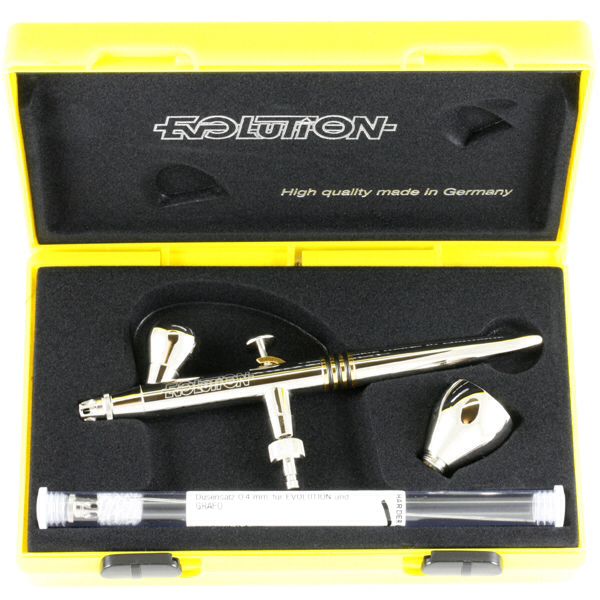 http://paintingplasticcrack.blogspot.co.uk
http://paintingplasticcrack.blogspot.co.uk
-
11-04-2013, 02:41 PM #5Librarian

- Join Date
- Mar 2011
- Posts
- 896

Here's a question that has been confounding me for months- I have an airbrush of the dual-action gravity-feed type (Iwata Revolution) and it seems every time I go to stop the feed, as I push the trigger forward it causes a big cough of paint to come out. What am I doing wrong?
Thank you for voxing the Church of Khorne, would you like to donate a skull to the Skull Throne today?
-
11-04-2013, 02:57 PM #6

Could be few things. Maybe your psi is too high, maybe you have a small blockage that's not enough to prevent you painting but enough to cause this "coughing" effect as you release the trigger.
I haven't used an Iwata brush, but I have read they are very good. It maybe your airbrush just needs a good clean.
95% of any issues I have had are down to my airbrush needing a damn good clean. Day to day cleaning with warm slightly soapy (dish soap ) is ok but sometimes you just need to strip the airbrush down and give it a really good clean using a proper airbrush cleaner and cleaning brushes. I bet if you give it a good clean and then try it on some paper you will be good to go.
I will go into some detail on cleaning and maintainance at some point, one piece of kit that's good is an ultrasonic cleaner. I bought mine for £20. I strip my brush down put it in the cleaner with warm water and a little soap and run it for about 10 minutes. It basically vibrates any hard to get to crap out of your brush.
If your brush is clean, then my guess is your psi is too high and your paints too thin.
Let me know how you get on.Last edited by Deadlift; 11-04-2013 at 03:40 PM.
http://paintingplasticcrack.blogspot.co.uk
-
11-04-2013, 03:31 PM #7

AIR SOURCES.
Right then let's talk about our compressed air supply. There's quite a number of ways of getting air into your airbrush. Canned pressurised air is one option, Badger do various sized cans and whilst starting out to begin with this option may look cheaper than buying a compressor, it's not. When you start out airbrushing and really start enjoying the results your getting, what can be worse than running out of air. This will happen if your using canned air. And if your planning on doing lots of airbrushing (it's addictive) you will spend a lot of cash on canned air. Don't do it.
Other options I have heard of are air tanks and even air filled tyres, I don't know about you guys but me that all sounds like a pain in the bum. If your really serious about airbrushing get a compressor.
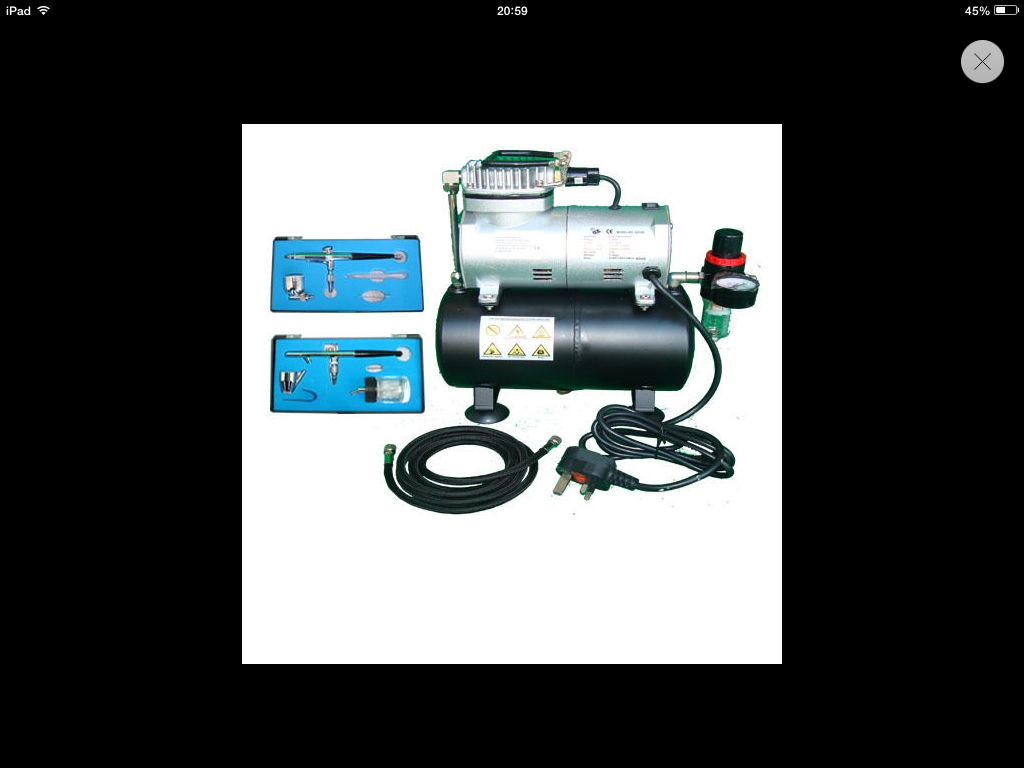
This is a pic of an Airbrush starter kit from eBay, it's what I started with and cost me about £65. With that I got a compressor with a tank and 2 airbrushes and all the air hoses I would need. Not the best brushes in the world but good enough to start with. Ones a gravity feed and ones a bottle feed, both are dual action.
Now be careful when choosing a compressor. You want one like this that has a tank, the reason being you will have a steady stream of air coming though your brush. What happens when you turn on the compressor is that it will fill the tank with air. As you use your brush and the pressure starts to drop your compressor will kick in and start adding air to the tank. Giving you uninterrupted painting with a constant flow of air. If you buy a compressor without a tank your airbrush will "pulse" as the air pressure drops and rises as you paint. I'm sure you can imagine the problems this can cause with painting.
Another thing to note is that with too much use, compressors can overheat. When they do they will switch themselves off. The 1st time this happened to me I thought I'd broken my compressor. 5 minutes of cool down time I was ready to go again. "Phew". So if this happens to you don't worry just be warned that your compressor needs a rest. Also take care it will be very hot to the touch.
All compressors (that we should be using) will come with a pressure valve, this is where we adjust our PSI. The higher the PSI, the more high pressured air and paint will come out of your airbrush, too high and you will explode paint everywhere you don't want it, too low and the paint will pool on your models and may even run. 20psi is good to start with, but play about with it to see what suits you.
So basically my advice when starting to airbrush is to get a kit like this one. It's cheaper than a wraithknight and you will be well on the road to getting started.
Next post I will cover setting up your painting area, paints and some safety tips. Talking of safety do please make sure when airbrushing your in a well ventilating area and your wearing a mask. I will cover this too in my next post.
TTFN.Last edited by Deadlift; 11-21-2013 at 03:18 AM.
http://paintingplasticcrack.blogspot.co.uk
-
11-04-2013, 04:18 PM #8Veteran-Sergeant

- Join Date
- Apr 2011
- Posts
- 204

Bravo. This is shaping up to be a good series of articles. How come these are in the Lounge rather than on the front page?
-
11-04-2013, 09:25 PM #9

Awesome, thanks for this. I'm new to airbrushing myself and I'm looking forward to your parts on painting techniques.
-
11-05-2013, 03:32 AM #10

Paint
Right then I've talked about airbrushes and compressors, next we need to think about our paint options, where we're going to paint and other bits and pieces we could use to make our airbrushing easier and fun. Here I will talk about paint
Now we really can use any of the paints we already use when we paint by hand.
GW paints can work in your airbrush but do need to be thinned. The problem I have found with GW paints is the pot and getting the paint from the pot into the airbrush. It's messy and a pain in the bum. I have seen some tip paint from the GW pots straight into the airbrush, add water (50/50) mix with a brush and start painting. Didn't work for me. If you insist on using GW paints I would buy some of these

You can add the paint into these dropper bottles, add your thinner (water or even a proper airbrush thinner) mix it in the bottle and the squirt your paint into your airbrush. Mess free and ready to go. You can even make enough to last some time and if your mixing your own colours this is a great way to do that too. I bought mine off of eBay and they are very cheap.
But there are 2 brands of paint I really like for airbrushing. Vallejo Model Air and Minitaire by Badger. Both are ready to go straight into your airbrush and don't require any thinning. They also come in dropper style bottles which is an even bigger bonus.
The Vallejo model air
This is really geared towards the scale modeller. The colours reflect this and so if your looking for bright purples or really vivid colours you won't find them in this range. Realism is what you get with this range of paints. I would think for an Imperial Guard player they would be fantastic. Some space marine chapters like Raptors or any of the black armoured chapters could be painted with this range very well. I should also add that if your looking for metallic airbrush paints, these are the very best. Very fine paint. Here's a chart of the colours available
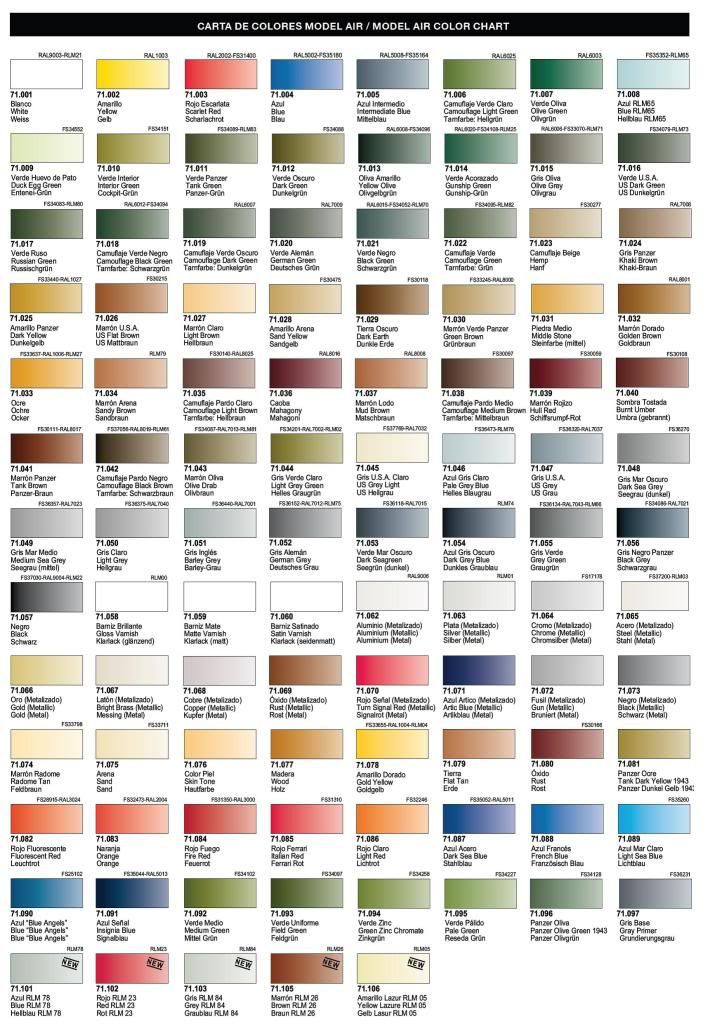
Badgers Minitaire paints.
This range is quite new and again come in dropper bottles. I think I discovered them around march time and they are really very good. Geared more towards the fantasy / sci if market this is where you will find some very bold colours. The names are really fun too. Bloodstained mud as an example. I really enjoy these paints and they fill a gap Vallejo's model air paints can't. Bright yellows, purples, reds and blues. Really any colour you could need is here. I don't rate their metallics though. The Vallejo ones are far better. But generally these are the paints I use primarily and the Vallejo model air paints are my back up paints.
Minitaire also do "Ghost" paints and these are a bit different than standard paint. Ghost paints are also referred to as "Candy" paints. We don't use these in the normal way for painting models and I will cover these in a later post as they really deserve their own section.
Here's the Minitaire chart

So that's paint, if your thinking of using GW paints then you will need to thin them, people say "consistency of milk" but I found that rather confusing. I found 50/50 is usually good enough as long as your paint hasn't begun to dry out. Don't mess about with old paint though, you will curse yourself silly after you clog your airbrush up and have to strip and clean it.
Last but not least we need primer. If you have an airbrush, why bother with expensive cans of paint, Vallejo airbrush primer is fantastic, I use white, black and grey. It's about £10 a bottle on eBay and I have managed to prime 4000 pts of Necrons and 2000 pts of eldar without going halfway though the bottle.
I repeat what I said before though, if your priming with an airbrush, up your psi a bit (30 is what I use) and remember you don't have to absolutely flood the model with the primer, a light coat is good enough for your paint to adhere to.
Any questions on paint don't be afraid to ask here or PM me.
I will cover our painting area next and some safety tips we should all follow.http://paintingplasticcrack.blogspot.co.uk



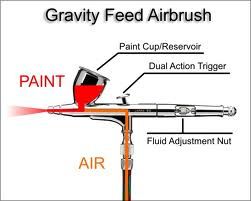
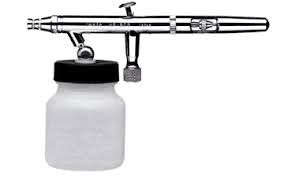

 Reply With Quote
Reply With Quote





